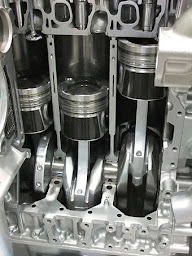Internal combustion engine(IC-Engine)
 |
| Engine |
Have you ever wondered what happens when you turn the key inside your car ignition, Here we will explain all the steps involved in the process from the ignition to the operation of the internal combustion engine. When you first get in your car , the first thing you do after putting the seatbelt on is to insert the key in the ignition switch to start the engine when the switch is turned on the electronic circuit between the battery and the starter motor is closed. The starter motor is an important element for the starting system. It allows the engine to reach the proper RPM(Revolution per mint) , so as to initiate the engines operation under it own power the starter motor essentially transforms the electrical energy into mechanical energy
Starter motor.
The starter motor is coupled to the flywheel in turn provides to transmit the motion to the cranks shaft,no the combustion cycle takes place inside the engine cylinders, so the starter motor is disconnected.
let’s see what happens inside the engine, taking the example of common four-stroke engine.
Four-stroke engine.
A four-stroke engine represents an example of efficiency and perfect synchronization ,it converts the explosion that occurs inside its combustion chamber into motion the aim of this engine is to use this energy to provide movement and transfer it to the wheels so that vehicle can move.
Cylinder.
It all takes place inside the cylinder ,here we can find combustion chamber where the explosions occur.
Piston.
The cylinder is basically the space through which the piston travels, the purpose of the piston is to transfer force from expanding gas in the cylinder to the crank shaft via piston rod or a connecting rod ,so that the back and forth linear motion of pistons is transformed into circular motion which can power the wheels but lets see this process more in detail by term four-stroke .
The he four-stroke is referred to the cycle of engine operation Which requires four stroke of the piston.
Intake-stroke
First stroke intake the valve must be in open position which the piston pulls an air fuel mixture into the cylinder by providing vacuum pressure through its downward the motion . the air fuel ratio is generally about 14:1 that’s because fuel cannot ignite alone. It is the oxygen in the air infect that provides the combustion of the fuel , what happens now that the air fuel mixtures inside the cylinder.
Compression.
Second stroke compression during this stage both the intake and exhaust valves are closed and the piston moves up the Chamber to the top, this cause compression of the fuel air mixture which decreases ten times its volume at this point pressure rises drastically as the air and fuel molecules are compressed together collide with each other and increasing the temperature.
Now we are ready for explosion.
Combustion.
Third stroke combustion and the expansion at the top of the compression stroke , the spark plug fires igniting the compressed air fuel mixture, this causes an explosion as the fuel burns .it expands increasing the pressure inside the cylinder and the driving the piston downward moving the twist, that rotates the crankshaft which will convert the energy of the explode into rotary motion.
Now lets the fourth and final stroke which is called Exhaust.
Exhaust.
During the exhaust stroke the piston once again return to the top while the exhaust valve is open , this action expels the spent air fuel mixture through the exhaust valve.
The four-stroke cycle is complete but it doesn’t here, at the speed of 6000rpms it repeats up to 50 times per sec, causing 200 explosion per sec inside each cylinder of this four-stroke engine.
Published by Science Tube, September 08, 2020
 Reviewed by Science Tube
on
September 08, 2020
Rating:
Reviewed by Science Tube
on
September 08, 2020
Rating:














No comments: